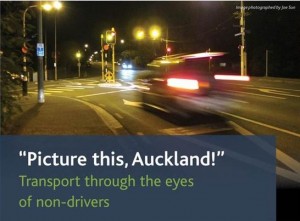 A new qualitative study of Auckland youth, led by the Adolescent Mobility Health Consortium (AMHC), suggests that young people who participated in this PhotoVoice exercise who do not drive cars choose buses, trains, cycling and walking mainly because they are more affordable and convenient transport options.
A new qualitative study of Auckland youth, led by the Adolescent Mobility Health Consortium (AMHC), suggests that young people who participated in this PhotoVoice exercise who do not drive cars choose buses, trains, cycling and walking mainly because they are more affordable and convenient transport options.
The study participants took photographs as a way to communicate their experiences. The purpose of the project was to create discussion about transport issues that was generated by the participants themselves. A selection of participant photographs will be on display at the Avondale Community Library in Auckland through September and can be seen on our PInterest channel.
Read original media release here.
Editors Note: Did you know even by age 19, less than a third of New Zealand teenagers have their full drivers license? (Source: Motor Vehicle Register, NZ Transport Agency)


Comments